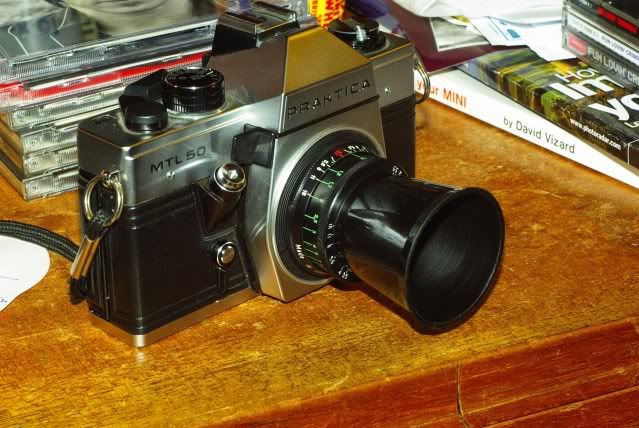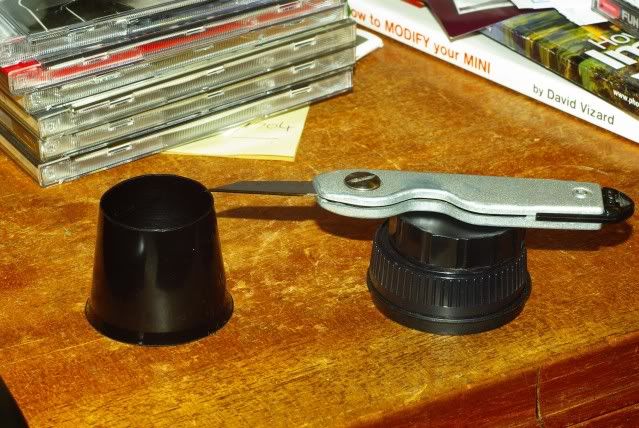Stephen
Lifetime Member
   Still collecting.......
Still collecting.......
Posts: 2,718
|
Post by Stephen on Oct 5, 2012 14:24:47 GMT -5
The shots shows show promise, the Tenax is sharp, but the age is against it a bit on contrast, and comparing a Novar to a Leica should be unfair in hard print terms, but display on a forum will rarely show the differences. Also the 24x24 format is smaller as well. My own Zeiss Tenax has had the lens cleaned, a long while ago, the rest of the camera is somewhat worn, but functions well.
Stephen
|
|
truls
Lifetime Member
  
Posts: 568
|
Post by truls on Oct 5, 2012 15:26:59 GMT -5
I wonder if I should dare to open the Tenax and clean it. I have not very much experience here, except from adjusting infinite focus on some newer lenses (Rikenon, Canon FD, Minolta MD). Is this risky?
|
|
Stephen
Lifetime Member
   Still collecting.......
Still collecting.......
Posts: 2,718
|
Post by Stephen on Oct 5, 2012 15:48:27 GMT -5
If you don't feel confident, or have the tools or can make the pin spanners that might be needed, then get an expert in.
I learnt years ago opening up cheap folders as a kid, stripping Prontors to find out how shutters worked etc. Most never worked again!!! but then they were from Jumble sales etc, and flea markets.
The Tenax is not easy, the lens is small, but conventional construction. from memory it starts with the back, and then release the front element, you can then clean all surfaces as it is a triplet.
Start with just the outer surfaces, a solution of water, hydrogen peroxide, and pure ammonia, I put a splash of both chemicals and make up with 60% water. Use clean quality tissue, or well washed thin cotton handkerchiefs, or specialist micro fibre cleaning cloth meant for lens cleaning.
Stephen.
|
|
truls
Lifetime Member
  
Posts: 568
|
Post by truls on Oct 6, 2012 8:08:46 GMT -5
I don't feel confident, but I will give it a try. Could I start another thread posting pictures of the progress? It would be a nice howto for others too.
|
|
|
|
Post by Peltigera on Oct 10, 2012 13:40:39 GMT -5
I have revisited my photos taken with my Tenax I and, actually, the main problem is a light leak. As the 'blanching' of the pictures is at the top, this would suggest a leak at the base of the camera - not where I would expect one to occur. I can see no evidence of any light-seal material but the back is fairly soft aluminium and not absolutely straight so that might be the problem except that the light is not leaking from the 'wobbles' in the back.   |
|
hansz
Lifetime Member
   Hans
Hans
Posts: 697
|
Post by hansz on Oct 10, 2012 14:19:20 GMT -5
Never knew that Tenax had a fish-eye lens...
|
|
Stephen
Lifetime Member
   Still collecting.......
Still collecting.......
Posts: 2,718
|
Post by Stephen on Oct 10, 2012 15:14:58 GMT -5
I don't think that is a light leak, it's far too even a "blanching" of the image across the frame, it is a lens contrast issue as Truls has in his Novar example. It is similar to having fungus glowing in the lens, or minute bubbles causing a "ghostly glow".
Light leaks nearly always show a colour shift on the film, edge effects and orange/yellow glow, not white ghosting.
Basically it is the bright area ghosting into the dark areas. From the Truls information, I think the glass in these Zeiss lenses is a dodgy wartime batch, leaving variable quality lenses. This did affect post war production of German lenses in general, they had to obtain completely new glass supplies after the war. The Russians removed a lot as well.
|
|
mickeyobe
Lifetime Member
   Resident President
Resident President
Posts: 7,280
|
Post by mickeyobe on Oct 10, 2012 17:56:08 GMT -5
I wonder if a lens hood might not improve your results.
|
|
|
|
Post by Peltigera on Oct 11, 2012 5:13:36 GMT -5
Mickey, I don't have a lens hood that small but I might try making one. If Stephen is right (and I suspect he is after a more careful look at the pictures) then the camera will have to go on the 'interesting but useless' shelf.
It is a pity Zeiss Ikon did not make this camera before the war as I find it delightful to use.
|
|
hansz
Lifetime Member
   Hans
Hans
Posts: 697
|
Post by hansz on Oct 11, 2012 6:06:56 GMT -5
Well, the Tenax I came into production in Mai 1939.
Wartime restricted the production to about 3000 units. Finding one of these is a challenge!
After the war Zeiss Ikon (Opton) decided not to refresh this design, but left it to the East to produce the Tenax.
Especially the first batches had quality problems...
So, there is hope!
Hans
|
|
truls
Lifetime Member
  
Posts: 568
|
Post by truls on Oct 11, 2012 6:47:21 GMT -5
A lens hood for the Tenax I could easily be made from an used 35mm film cartridge, just cut it in half and apply with some Scotch tape, it will fit nicely. The lens is exposed to unwanted light and a hood comes in handy. Maybe it should be painted inside black matte to reduce light stray.
If picture quality is most important Tenax I is not the camera of choice. I like the old look of the pictures, and if I can improve the quality by doing som lens cleaning I am happy. Anyway it is a nice camera showing a bit of camera history at the time. peltigera's shots are sharp but shows the same artifacts as my pics.
|
|
|
|
Post by Peltigera on Oct 11, 2012 7:09:48 GMT -5
It looks like it will, Truls. I will try that this evening when I have some spare time.
|
|
lloydy
Lifetime Member
  
Posts: 506
|
Post by lloydy on Oct 11, 2012 16:52:36 GMT -5
Mickey, I don't have a lens hood that small but I might try making one. If Stephen is right (and I suspect he is after a more careful look at the pictures) then the camera will have to go on the 'interesting but useless' shelf. It is a pity Zeiss Ikon did not make this camera before the war as I find it delightful to use. I made a small lens hood for an Industar 50 from a GU Pot, which is a chocolate desert. First eat the chocolate goodness, you might need more than one in the interests of making a perfect hood. Then cut the base off using a very sharp knife. Get permission from matron when using sharp things though  I hold the knife firmly on the table, maybe spaced up on something solid, and while pressing the pot down on the table I revolve it against the blade - if that makes sense, a bit like a lathe where the work moves against a fixed tool. ( the picture is posed for illustration purposes only, no fingers were lost in the staging of this picture ) I measure as best I can where to cut on the tapered pot, but adjustment, or more pots, is often required. I make the hood a snug fit over the lens. The GU Pots are shiny black plastic, so I matt the inside with an abrasive such as the 3M Scothbrite, some washing up scourers are abrasive enough as well. It's cheap, it's flexible, I don't really care if I lose one, I just eat more chocolate goodness and make another. ;D   Lens cap from an aerosol can lid.  |
|
mickeyobe
Lifetime Member
   Resident President
Resident President
Posts: 7,280
|
Post by mickeyobe on Oct 11, 2012 17:22:11 GMT -5
Lloydy,
CHOCOLATE!
You have made the ultimate camera accessory. Nothing could be better.
I wonder if there is a Nobel prize.
|
|